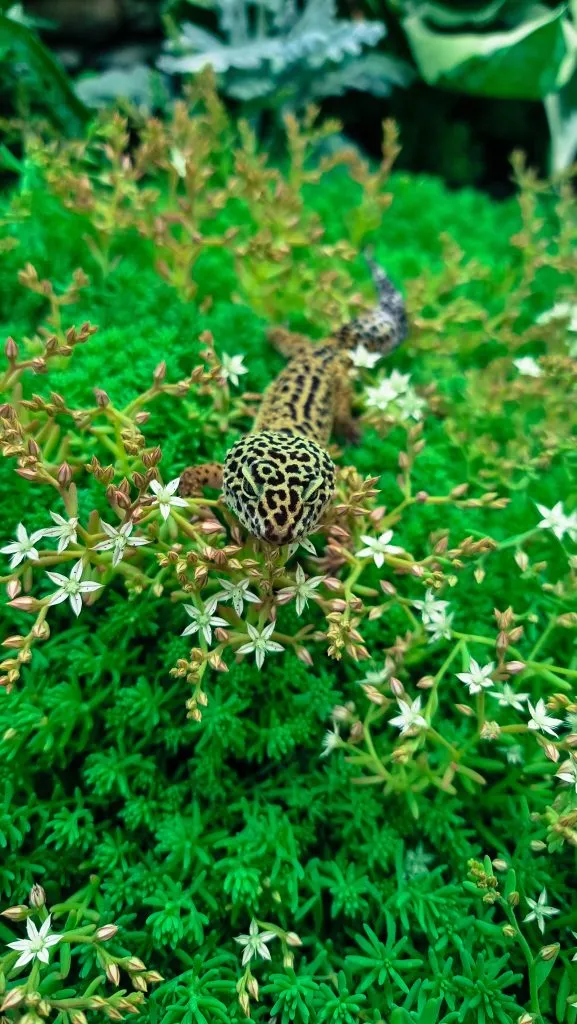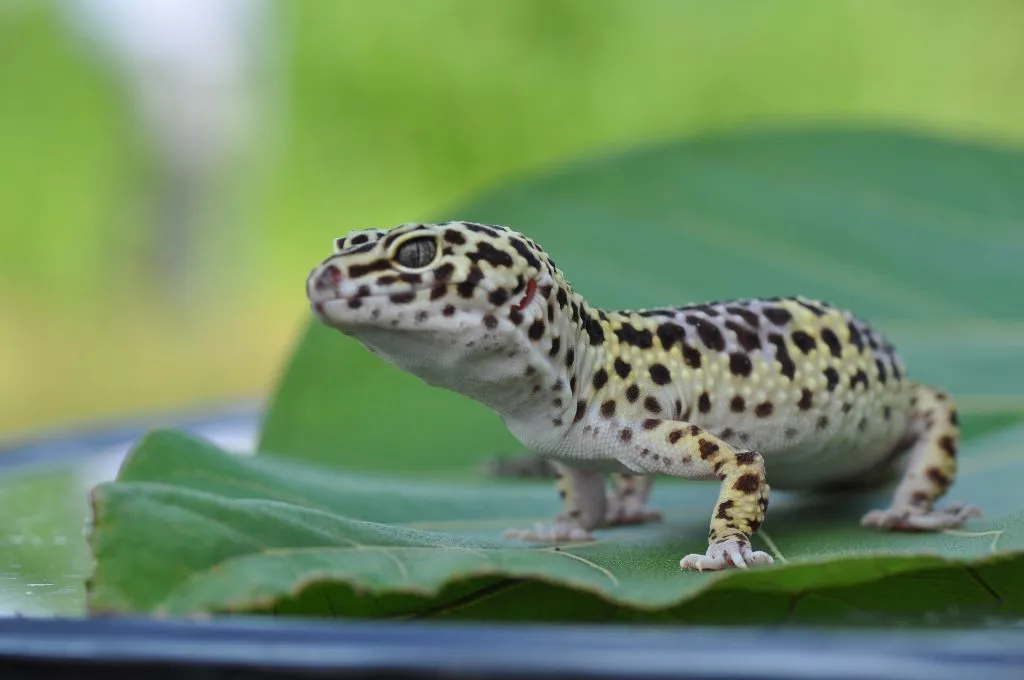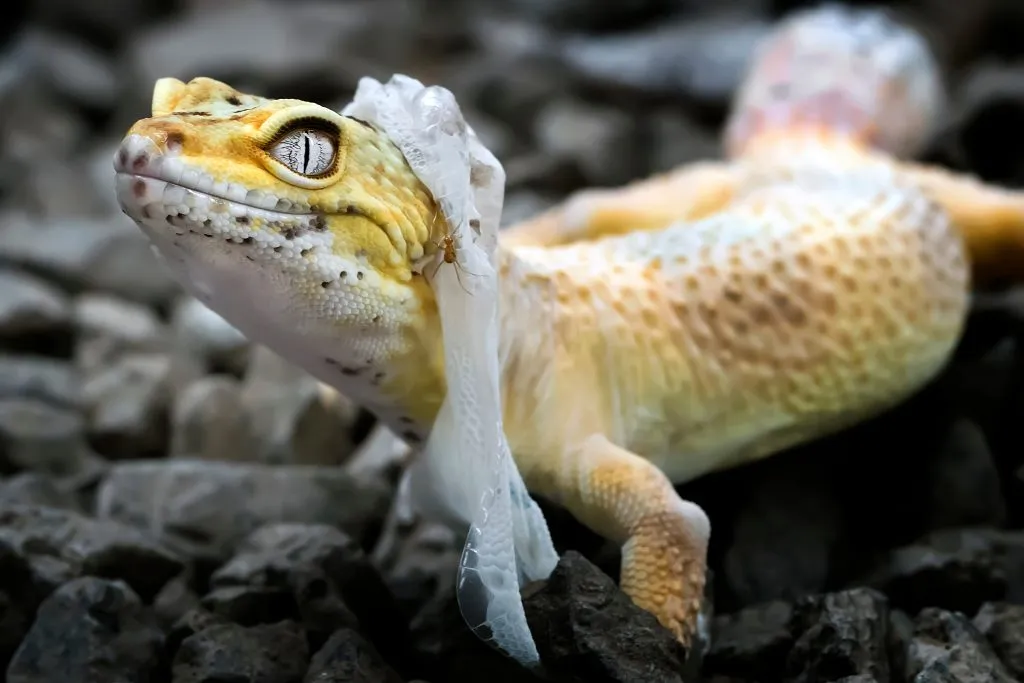
Leopard geckos are popular pets well-liked for their interesting appearance and relatively easy care requirements. They have a distinctively stout tail where they deposit a large amount of fat at the tail base. Unfortunately, leopard geckos are prone to developing tail-related health problems, one of which is tail rot.
Tail rot or avascular necrosis in leopard geckos is caused by improper shedding, bacterial infection, trauma, injury, or inadequate housing factors that lead to restricted blood flow to the tail, causing it to die and fall off. Providing proper care and husbandy is essential in preventing tail rot.
It is crucial to keep an eye out for signs of tail rot to prevent it from taking a serious toll on your beloved pet. This article will help you spot out the symptoms of tail rot, what you can do to as first aid and prevention, and how to treat it with the help of your resident herp vet.
Table of Contents
What Does Tail Rot Look Like in Leopard Geckos?
Tail rot is a common health issue that affects leopard geckos, and it is essential for owners to be able to recognize the common signs of this condition.
In this section, we will discuss in detail what tail rot looks like in leopard geckos.
The early signs of tail rot may not be noticeable, but as the condition progresses, it becomes more apparent.
The first sign of tail rot is discoloration or darkening of the tail. The tail may become black or brown in color, and the skin may feel mushy or soft to the touch.
In the early stages of tail rot, the affected area may first appear swollen due to the constriction of blood flow and inflammation.
However, as the condition progresses, the tail will eventually appear thinner, smaller, and wrinkled as it loses the blood supply that it should be receiving.
In cases of tail rot where infection is involved, The skin may form pus. A pungent odor may emanate from the area, and this is an indication that the bacterial infection has become severe.
In severe cases, the affected portion of the tail may start to detach, indicating that the tissue has died.
The tail may eventually fall off completely, but in many cases, your leopard gecko will show signs of stress, such as lethargy and obsessively biting or tending to its tail, showing pain and discomfort.
It is important to keep in mind that not all discoloration or dropping of the tail is a sign of tail rot.
Leopard geckos exhibit tail autotomy, a natural defense mechanism that allows them to spontaneously drop their tail with minimal blood loss when they feel threatened. The tail eventually regrows.
Tail dropping from autotomy, a natural physiological process, is different from a tail detaching from your leopard gecko due to necrosis.
The latter is a pathological condition, and thus, if you observe any of the above-mentioned symptoms that suggest tail rot, it is imperative to take your leopard gecko to the veterinarian immediately.
Can Leopard Geckos Die From Tail Rot?
The short answer is yes, tail rot can be deadly when left untreated, and the severity of how the condition progresses depends greatly on how quickly it is diagnosed and treated.
In severe cases, tail rot can cause the gecko to go into shock, especially from stress and pain. Septicemia may also occur when infection is involved.
This happens when the bacterial infection enters the bloodstream and spreads throughout the body, resulting in multiple organ failure.

However, not all cases of tail rot are fatal. With prompt veterinary care, many leopard geckos can recover from tail rot and live healthy, normal lives.
Treatment generally involves cleaning the affected area, administering antibiotics, and performing surgery as deemed necessary. This will be further discussed later.
What Are The Causes of Tail Rot in Leopard Geckos?
Several factors can cause tail rot in leopard geckos, but all of them ultimately lead to the disruption of the blood circulation to the tail, and this is what eventually causes avascular necrosis.
Improper Shedding
Dysecdysis is one of the most common health issues and causes of tail rot in leopard geckos. Like most other lizards, they shed their skin periodically and it comes off in patches.
Pieces of skin can be more difficult to come off in certain parts of a leopard gecko’s body, specifically around the fingers and tail.
As the retained shed builds up without being removed, it eventually constricts the blood flow to the affected areas, causing avascular necrosis.
Fingers and tail that have died off due to lack of blood flow eventually fall off.
Improper shedding is caused by a multitude of factors, but most frequently, dehydration, inadequate humidity, and malnutrition predispose a leopard gecko’s risk to dysecdysis.
Tail Infection
Tail infection is another common cause of tail rot in leopard geckos. The tail can become infected due to small cuts or wounds that allow bacteria to enter the body.
If left untreated, the infection can spread, causing the tissue to die and leading to tail rot.
Tail infections can occur due to inadequate hygiene, sharp surfaces in the enclosure, and injuries caused by fighting with other geckos.
Necrotic dermatitis caused by bacteria such as Aeromonas and Pseudomonas species are more common in reptiles that are kept in dirty enclosures with excessive humidity and moisture.
Often, bacterial infection is not the primary cause of tail rot, but is a common complication that worsens the progress of the disease.
When tail rot is accompanied by bacterial dermatitis, the skin may appear red, inflamed, and ulcerated. Blisters, pus, and abscesses with foul-smelling odor may also form.
Trauma and Injury
Tail rot can be a potential consequence of trauma or injury in leopard geckos. Such incidents can result in harm to the blood vessels, nerves, and tissues, causing decreased blood circulation and heightened susceptibility to infections.
Tail injuries may arise due to incorrect handling or territorial clashes with other geckos and reptiles.
An extremely defensive lizard may also repeatedly hit its tail against surfaces or objects of the enclosure, causing blood vessels to break or clots to form, which lead to obstruction of blood flow.
To prevent injuries from occuring, leopard gecko owners must learn how to properly handle their pets and to be careful about choosing tankmates for their geckos.
Inadequate Housing Requirements
Leopard geckos require specific temperature and humidity levels, appropriate substrate, and sufficient hiding places and climbing structures in their enclosure.
Failure to provide adequate housing can cause stress and increase the risk of tail rot and other health issues.
Malnutrition and Stress

Poor nutrition results from a diet lacking in essential nutrients like calcium, vitamin D3, vitamin A and vitamin C.
Insufficient nutrition weakens the immune system and causes improper shedding, making geckos more prone to infections and illnesses, including tail rot.
Malnutrition also leads to chronic stress, which is another factor that can lead to tail rot by weakening the immune system of your leopard gecko.
Other causes of stress include inadequate hiding places or climbing structures, overcrowding, and frequent handling, especially during the shedding period.
What Is the Treatment For Tail Rot in Leopard Geckos?
The initial step in managing tail rot involves isolating the affected gecko to prevent infection transmission to other geckos. Next, a veterinarian should assess the severity of the condition and recommend suitable treatment.
If detected early, tail rot can be remedied with topical antibiotics and frequent cleaning.
The infected region should be cleaned with a mild antiseptic solution such as diluted povidone-iodine or veterinary Betadine, and topical antibiotics are applied to prevent infection.
It is necessary to maintain a clean and sterile environment with appropriate humidity levels to facilitate healing.
In severe cases, surgery may be required to eliminate the infected tissue and prevent the spread of infection.
This procedure is usually performed by a veterinarian who will place your leopard gecko under local or general anesthesia.
After surgery, the gecko will require extra care and monitoring to ensure proper recovery. Your vet may also prescribe additional medications that they deem necessary, such as anti-pain medicine, vitamins, or immune boosters.
It should be emphasized that sometimes, tail amputation may be the best option to preserve your leopard gecko’s quality of life.
In such cases, caudal autotomy is an advantage for leopard geckos as it will allow them to regenerate their tail, although not exactly as identical as their original one.
Can I Make My Leopard Gecko Drop Its Tail Instead?
Leopard geckos have a unique ability to drop their tail when they feel threatened or stressed, which can help them escape from predators.
This process is known as caudal autotomy and is a natural defense mechanism for the gecko.
While leopard geckos can regrow their tails after they are dropped, constantly dropping and regrowing the tail can lead to chronic stress and illness.
Many owners may wonder if it would be helpful to force their leopard gecko drop its tail to get rid of tail rot. It is not recommended to force a leopard gecko to drop its tail as it can be a traumatic experience for the gecko and may cause more harm than good.

Force dropping is difficult, and ultimately it means inducing more stress on an animal that is already in pain or discomfort.
Rather than forcing a leopard gecko to drop its tail, it is recommended to bring the gecko to a veterinarian who can examine the tail and determine the best course of treatment.
In some cases, surgery may be necessary to aseptically amputate the tail and prevent the spread of infection. This is obviously a better option than waiting or forcing your leopard gecko to drop its tail.
The good news is that a leopard gecko’s tail that is surgically amputated can still regrow, given the proper post-operative care. Tail regrowth occurs over a period of 4 to 8 weeks.
Can You Treat Tail Rot At Home?
While there are steps you can take at home to prevent tail rot, it is not recommended to attempt to treat it at home.
Attempting to treat tail rot can be dangerous and may exacerbate the condition. Additionally, many over-the-counter treatments and remedies can do more harm than good.
Treatment of tail rot requires immediate consultation with a herp vet who has the expertise and equipment necessary to diagnose and treat the condition.
How Can Tail Rot in Leopard Geckos Be Prevented?
Tail rot is best prevented by maintaining adequate husbandry and proper care to prevent common triggers that lead to necrosis.
Maintain Proper Husbandry
The initial measure to prevent tail rot in leopard geckos is to ensure appropriate husbandry.
This involves setting up the gecko’s enclosure properly, including providing a temperature gradient, with a warm area of 84-88°F (29-31°C) and a cooler end from 70°F (21°C).
Proper lighting with a 12-hour light/dark cycle and humidity levels between 30-40% are also necessary. Install at least two thermometers and two hygrometers on both the cool and warm side of the enclosure to monitor temperature and humidity.
Because leopard geckos are terrestrial lizards, an ideal enclosure should be longer than it is tall.
A 20-gallon

However, you should only keep one male per aquarium to prevent territorial aggression and fighting.
Ensure proper ventilation so that the substrate and other elements inside the enclosure do not remain wet for a long period of time.
This may be done by fitting a screen lid on top. Leopard geckos are nocturnal creatures, so UVB lighting is not essential but can have benefits.
Regularly disinfect the enclosure and tank decor and replace the substrate at least weekly.
You can spot clean using this safe terrarium cleaner, while for major disinfection, you can dilute half a cup of household bleach in a gallon of water. Ensure that everything is thoroughly rinsed.
| Husbandry Feature | Description |
| Cage size | At least a 20-gallon long Only one male per |
| Temperature | 84-88°F (29-31°C) on the warm end from 70°F (21°C) on the cool end |
| Humidity | 30-40% |
Offer a Balanced Diet
To prevent tail rot in leopard geckos, it is crucial to provide a balanced and nutritious diet. Various insects such as crickets, mealworms, waxworms, and roaches should be offered.
An occasional pinkie mouse can also provide added nutrition to adult geckos.
Ensure that the insects are gut-loaded 24 hours before feeding and dusted with supplements.
Leopard geckos generally need reptile multivitamins with calcium, vitamin D3, and vitamin A dusted on their
In general, juvenile geckos and gravid females should be supplemented at every feeding, while adult leopard geckos only need to be supplemented every 2-3 feedings.
However, it is best to consult your vet regarding the volume and frequency of feeding any supplementation.
Although most leopard geckos are accustomed to feeding on live, moving prey, crickets should be avoided when your gecko has just dropped its tail or, for some other reason, has an open wound.
Instead, you may feed it insects using tongs like these.
Encourage Proper Shedding

Shedding is a normal physiological process among reptiles. Young leopard geckos can shed as frequently as every 10 days to keep up with their drastic growth.
Adults, on the other hand, regularly shed every 3 to 4 weeks.
Proper shedding is necessary for preventing tail rot. Aside from maintaining optimal humidity, provide a moist hide box (we recommend this one) to assist your gecko in shedding properly.
The moist hide box can be created by placing a small container of damp sphagnum moss, cypress mulch, or vermiculite in the enclosure.
A moist hide box doubles as both a good hiding place for your leopard gecko, as well as a damp area to help facilitate proper shedding.
Mist the hide box every day to keep it damp but not soaking wet. You may also provide a shallow water dish to provide hydration, and remember to change the water daily.
Early observation of shedding problems will allow you to make the necessary interventions to help your leopard gecko get rid of retained shed.
For minor trouble spots, lightly spray with lukewarm water before gently massaging the stuck shed off with a damp cotton tip or paper towel.
For larger areas of unshed skin, you may try to place your leopard gecko in a warm water bath mixed with this shedding aid solution for 10-20 minutes before gently massaging again.
Vitamin A supplementation (which should be part of most reptile multivitamins) on top of optimal hydration is helpful in facilitating the separation of old and new skin during shedding.
Prompt Injury Treatment
If your leopard gecko suffers an injury, it is crucial to provide prompt first aid before bringing it to the vet.
Stop any form of bleeding by applying pressure to the site with a small cloth or paper towel. Use sterile saline solution to flush out debris.
Apply an antiseptic solution on the open wound to prevent infection, such as this wound spray formulated for reptiles or 1 part 10% povidone-iodine (Betadine) diluted in 3 parts water.
Regular Health Checks
Conducting regular health checks is essential for preventing tail rot. Keep an eye out for signs of tail rot, such as black or necrotic tissue on the tail, and for any signs of injury, such as cuts or abrasions.
Regular health checks can identify issues early on and prevent them from becoming severe.
Conclusion
Tail rot is a serious condition that can affect the health and well-being of your leopard gecko. It can be caused by various factors, such as improper shedding, trauma/injury, and infections.
Prevention mainly involves maintaining adequate care and housing requirements and going for regular health check-ups.
While there are some first-aid measures you can take at home to prevent tail rot, such as helping your leopard gecko shed properly, it is not recommended to treat tail rot at home.
Only a herp vet can provide the proper treatment, and in some cases, amputation will be necessary.
It is also important to note that while leopard geckos can drop their tail and regrow it back, constantly dropping and regrowing can lead to stress and illness.
Therefore, it is not recommended to force your leopard gecko to drop its tail as a treatment for tail rot.
- Enchi Ball Python: A Unique and Stunning Morph of Python regius - March 27, 2025
- Emerald Tree Monitor: The Enigmatic Green Guardian of the Rainforest - March 26, 2025
- The Egyptian Cobra (Naja haje): A Fascinating Serpent - March 25, 2025
